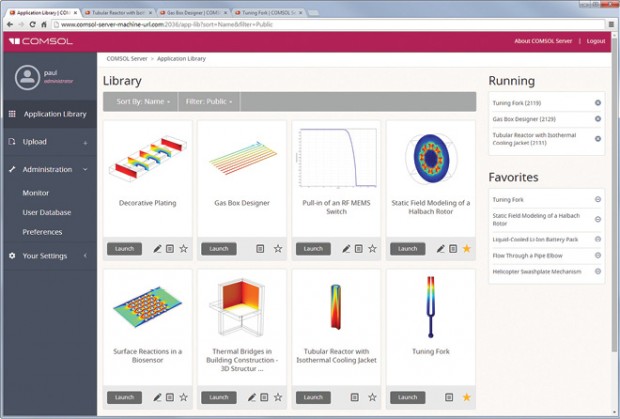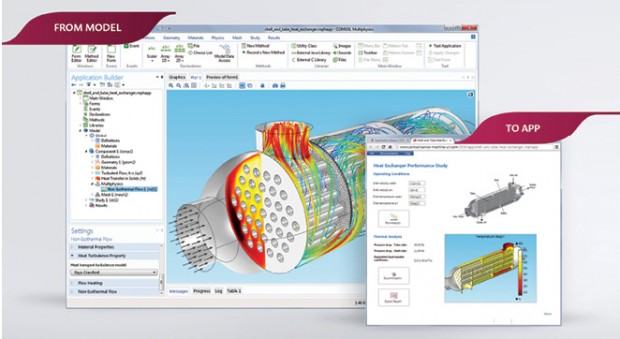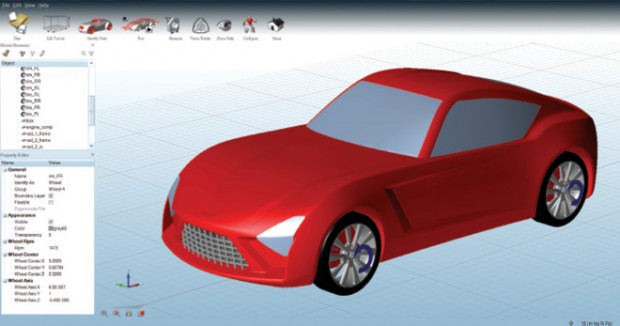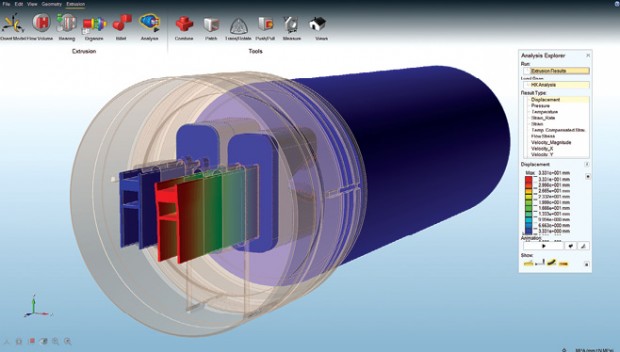
COMSOL’s Application Builder lets COMSOL Multiphysics software users turn their simulation models into apps, in a simpler interface suitable for use by non-experts. Image courtesy of COMSOL.
Latest News
April 1, 2015
 COMSOL’s Application Builder lets COMSOL Multiphysics software users turn their simulation models into apps, in a simpler interface suitable for use by non-experts. Image courtesy of COMSOL.
COMSOL’s Application Builder lets COMSOL Multiphysics software users turn their simulation models into apps, in a simpler interface suitable for use by non-experts. Image courtesy of COMSOL.Most of my digital photos end up in one of two programs: Adobe Photoshop or Instagram (now part of Facebook). I’ve had Photoshop for five to six years. I began using Instagram about a year and a half ago. But these days I found myself using Instagram 80% of the time to process my photos, and Photoshop the other 20%.
Whether it’s a dramatic increase in contrast, a highly saturated look or a sepia-tone flush, I can get that in Instagram with just a few touches. Sure, I can get the same look in Photoshop, but it means going step by step, experimenting with the contrast and color sliders one at a time until I arrive at the desired effect. This offers a clue to how some companies are planning to broaden the reach of software-based simulation, currently the domain of experts.
On Apple’s App Store and Google Play, you’ll find Autodesk ForceEffect. ForceEffect Flow and ForceEffect Motion, three mobile apps that let you calculate stress, visualize fluid and airflow, and examine movements in mechanical structures without the burden and the learning curve of a general purpose simulation program. In late 2013, Altair Engineering launched HyperWorks Virtual Wind Tunnel and, more recently, HyperXtrude in 2015, special programs built to simulate external aerodynamics and metal extrusion. In October 2014, COMSOL released a new version of its multiphysics simulation software with the Application Builder, which let users publish and share simulation apps.
Over the last two years, Comet Solutions has been developing a broad catalog of simulation apps, dubbed SimApps, many of which are deployed via Web interfaces. These may be harbingers of simulation marketplaces, populated with simplified, template-driven simulation applets that let you bypass or augment general-purpose simulation programs.
The Origin of Templates
In the past decade, CAE software developers experimented with various methods to broaden their market. Some introduced CAD plug-ins. Others repackaged their products in industry-specific configurations. For example, Dassault’s SIMULIA brand products exist in different flavors for biomedical, life sciences, consumer goods, and other industries. They all succeeded in demystifying the black art once confined to the realm of PhDs. But one fundamental challenge still remains. Whether it’s a car crash, the airflow around a plane, or the kinematics of a crankshaft, recreating a complex physical event inside a general-purpose simulation program is inherently complicated. That hurdle prompted many to resort to templates.
“Templates are a trend mostly among large companies that have method groups or have established best practices,” says Gilles Eggenspieler, CFD (computational fluid dynamics) product line manager at ANSYS. Such time-tested workflows can be encapsulated in expert-built templates so non-experts can perform simulation at their own convenience with little or no expert intervention.
“[Templates and apps] give the amateur or introductory level user the ability to be productive without learning the simulation software,” says Derrek Cooper, lead for CAE and HPC (high-performance computing) product lines at Autodesk. But to build a template, you still need an expert who knows the software inside-out — something not every business possesses. Currently, some consultants and freelancers fill that void for companies without in-house talent.
Some of ANSYS’ customers, for instance, hire ANSYS to build simulation templates for them. “If you are GM or GE, for example, you may have resources to build a template on your own. Other organizations without resources may subcontract the template building to outside sources,” says Bruno Reymond, general manager of ANSYS France. In time, the practice caught the attention of software developers, who woke up to the need to include robust workflow automation or template-building functions.
Automation Features
There is now an additional burden on CAE vendors. They’re expected to deliver not only general-purpose programs that can solve a range of structural and fluid dynamics scenarios but also include tools that make template-publishing or workflow automation possible.
“Many of our products in the HyperWorks suite, for example SimLab, have template systems built right into their tools. This is especially attractive for larger companies with significant numbers of users, or companies that work with multiple vendors to complete their CAE process,” says Christopher Peterson, director of User Experience at Altair.
Peterson also pointed out the difficulty of inventing targeted templates and apps. “Even within the same industry, modeling and analysis standards vary from company to company. Bottom line, the applications we deliver are customizable, a goal which is uniquely supported by Altair’s open architecture,” he says.
 Altair’s HyperWorks Virtual Wind Tunnel is an example of simulation that is being customized as specialized applications.
Altair’s HyperWorks Virtual Wind Tunnel is an example of simulation that is being customized as specialized applications.Image courtesy of Altair.
ANSYS 16.0 comes preloaded with ACT templates, covering a wide range of wizards. “They are made in a way that’s easy to develop (in XML and Python languages) and to deploy without the need for additional licenses. They enable organizations to easily repeat simulations, capture product and process knowledge, and reduce training and implementation barriers for non-expert simulation users,” ANSYS’ Reymond says.
The sole purpose of Comet Workspace from Comet Solutions is to rapidly and easily create automation templates, according to Malcolm Panthaki, founder and CTO of Comet Solutions. “While templates have been around for a while, they required a lot of scripting and programming, making them expensive to create and maintain,” he says. “The Comet Workspace is designed to create templates graphically, with a minimal amount of scripting.”
San Francisco-based Rescale has built a business by offering on-demand HPC infrastructure to companies that want to pursue large-scale simulation. But part of its value may be coming from the software layer that allows automation.
“As part of the Rescale toolset, we offer templates that let you set up a combination of software and algorithmic applications, so you can run design of experiments, Monte Carlo algorithms, or optimization sessions. Once you set up that workflow, it can be cloned so that you can change just a few parameters and rerun this job. The other popular feature of ours is the ability to share the workflow that you have set up with other people,” says Joris Poort, CEO of Rescale.
Design Automation Associates (DAA), an engineering consultant, has made process automation its specialty. According to John Lambert, DAA’s president and CEO, “Iterative problems occur in all areas of engineering design and analysis, but they especially occur in companies with engineered-to-order and configured-to-order products,” says John Lambert, president and CEO of DAA.
Finite element analysis (FEA) of a printed circuit board (PCB) destined for use in an aerospace application, for example, provides the ideal conditions for automation.
DAA’s PCB analysis automation framework was built on Siemens PLM (product lifecycle management) Software’s NX. DAA automated the mesh generation and iterative frequency extraction using NX’s common application programming interface that supports a number of popular programming languages. Lambert estimated that the automation cut down the analysis that previously required 40 hours to a mere 15 minutes. The efforts required to set up the automation, however, is considerable. “It takes approximately 10 times as long to create a somewhat robust automation routine as it does to run a single iteration, so not everything is appropriate for automation,” he says.
 Altair also has HyperXtrude, which can help users simulate extrusions for shop floor equipment. Image courtesy of Altair.
Altair also has HyperXtrude, which can help users simulate extrusions for shop floor equipment. Image courtesy of Altair.In most cases, such process automations are nested inside a simulation program; therefore, they require the non-experts to have some rudimentary knowledge of FEA software. Comet’s Panthaki doesn’t think that goes far enough. “Our experience clearly tells us, however easy you make those general purpose tools, the non-experts will still find it extremely difficult to use, because setting up models for simulation is difficult,” Panthaki says. He thinks the secret to mass-adoption of simulation is to “bypass the general-purpose simulation software interface altogether and create Web-deployable apps that have simple interfaces that speak the language of the engineer.”
FEA App Store, CFD Marketplace
The idea of an online marketplace populated with thermal, structural, airflow and fluid flow simulation apps for specific tasks is not as farfetched as you might think. Some versions of this are already in incubation.
In the ANSYS Customer Portal, there are extension libraries under the Download section, where you’ll find apps and templates built by third parties or ANSYS.
After releasing COMSOL Multiphysics 5.0 with Application Builder, COMSOL is now laying the groundwork for an app universe with its COMSOL Server, described as “the engine for running simulation apps and the platform for controlling their deployment and distribution.”
“The future of simulation app stores isn’t far off at all. In fact, we have made considerable progress in this direction with the Altair Partner Alliance, which opened our platform to third party applications that take advantage of our on-demand software licensing system,” says Altair’s Peterson.
 With the introduction of COMSOL Server, COMSOL is laying the groundwork for housing a collection of simulation apps. Image courtesy of COMSOL.
With the introduction of COMSOL Server, COMSOL is laying the groundwork for housing a collection of simulation apps. Image courtesy of COMSOL.This is not about delivering a general-purpose simulation program from the cloud (for that topic, read “A Map to Simulation on the Cloud,” July 2014). Rather, this is about delivering small, purpose-built apps that let you perform simulation with little to no knowledge of simulation software.
Comet’s library of SimApps range from simple to highly-complex models. For example, a Driveline SimApp is described as, “A single environment for axle system design that allows quick and easy evaluation of any axle geometry, without the manual effort.” Its Electro-Optical Sensor SimApp lets you conduct integrated structural, thermal and optical performance analysis on space-borne EO sensors. Its Socket Stack Assembly SimApp is used by Intel to perform complex socket chip stack analysis using Abaqus.
“Vendors and customers have been creating these vertical apps for a long time, but they often only work across a small range of the design space. Using abstract modeling, Comet’s templates can work across geometry and topology changes, across an entire family of products that shares a common functional architecture. This is important — if the range of utility of a template is narrow, as is often the case today, then the template is not very useful,” Panthaki says.
Autodesk’s Cooper thinks the online marketplace idea is spot on, but the challenge is to identify certain simulation tasks that make sense economically for the provider. “To be successful, you have to look for a problem that’s pervasive enough to affect a lot of people, something sufficiently time-consuming but simple in nature,” he says.
“I don’t want to discount the possibility of a simulation app marketplace. That’s certainly is a possibility, but it will be very challenging to do it for complex workflows,” says S. Ravi Shankar, director of Simulation Product Marketing at Siemens PLM Software.
If software vendors do start adding more robust app-publishing functions in the software, consultants and CAE software users with sufficient knowledge in their own fields will likely become app developers. That means simulation analysts and researchers may very well be the ones who come up with the simulation equivalent of Instagram.
More Info:
Subscribe to our FREE magazine, FREE email newsletters or both!
Latest News
About the Author
Kenneth Wong is Digital Engineering’s resident blogger and senior editor. Email him at [email protected] or share your thoughts on this article at digitaleng.news/facebook.
Follow DE





